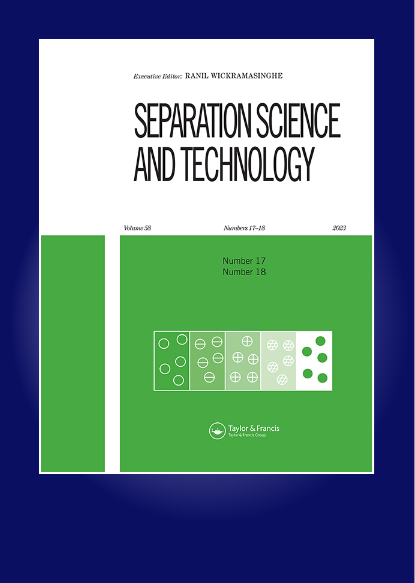The potential of a natural Ecuadorian mordenite-type zeolite for batch and column selenium removal
IF 2.3
4区 工程技术
Q3 CHEMISTRY, MULTIDISCIPLINARY
引用次数: 0
Abstract
ABSTRACTSelenium is found in natural waters of developing countries. The present study refers to Se (IV) adsorption onto an Ecuadorian natural zeolite, activated at 225°C. Its physicochemical characterization included particle size analysis, XRD, SEM-EDX, and FTIR. After selenium adsorption, the FTIR spectra denoted the presence of moved bands and new peaks, probably corresponding to new metal bond vibrations. Batch experiments were carried out at 26°C, for 2 h, at adsorbate doses within 0.01–50 mg L−1, bringing about a removal percentage in the range of 57−90%. Eventually, Se (IV) adsorption was performed at a pH of 7.5, resembling realistic well-water matrix conditions. Zeolite accomplished a maximum Se adsorption capacity of 53 mg g−1 zeolite, corresponding to roughly 90% of Se removal. The results obtained upon constant flow mode were analyzed with various kinetic models, appearing Thomas and BDST models to fit better. The highest Se removal percentage on typical well waters leaves a Se value lower than the permissible levels. Thus, natural zeolites offer an economic and competitive alternative for Se (IV) removal, especially from groundwater and industrial wastewater in developing countries.KEYWORDS: Adsorption bed columnsadsorption isotherm modelsadsorption selenium removalbreakthrough curvesnatural zeolites Highlights Batch experiments with doses resembling groundwater and industrial waters brought about 57% 90% Se removal.Se (IV) adsorption could be successfully attained at pH 7.5, thus avoiding chemicals usage.Natural mordenite-type zeolite accomplished a maximum Se adsorption capacity of 53 µg L–1 zeolite.Kinetic studies from Se adsorption on column fit well Thomas and BDST models.The highest Se removal percentage at groundwater levels leaves a Se value lower than permissible levels.Disclosure statementNo potential conflict of interest was reported by the author(s).Data availability statementThe data that support the findings of this study are available on request from the corresponding author.Statement of noveltyThe present study deals with the treatment of water contaminated with selenium, a typical nonmetal in groundwaters generated from industrial activities. The metal has been proposed to be removed using the adsorption principle onto a natural mordenite-type zeolite, on which scarce studies are reported for selenium removal, unlike artificial ones. In a particular way, the study is outstanding because it also compares Se adsorption on natural and artificial mordenite and intentionally declines the most suitable adsorption conditions to favor others which still results in practical, i.e., pH adjustment avoidance, consequently avoiding chemical usage. Upon these conditions, batch and column trials were performed. Finally, the strategy brings economic and environmental benefits such as reducing costs, especially for developing countries, where inexpensive adsorption technologies are not common.Supplementary materialSupplemental data for this article can be accessed online at https://doi.org/10.1080/01496395.2023.2250549天然厄瓜多尔丝光沸石型沸石用于间歇和柱式除硒的潜力
摘要发展中国家的天然水体中含有硒。本研究是指在225°C活化的厄瓜多尔天然沸石上吸附Se (IV)。其理化性质包括粒度分析、XRD、SEM-EDX和FTIR。吸附硒后,FTIR光谱显示存在移动的条带和新的峰,可能对应于新的金属键振动。在26℃条件下,在0.01 ~ 50 mg L−1的吸附剂剂量范围内,进行了2 h的批量实验,去除率为57 ~ 90%。最终,在pH为7.5的条件下进行Se (IV)吸附,类似于现实的井水基质条件。沸石的最大硒吸附量为53 mg g−1,相当于约90%的硒去除率。用各种动力学模型对恒流模式下的结果进行了分析,得到了较好的Thomas模型和BDST模型。典型井水的最高硒去除百分比使硒值低于允许水平。因此,天然沸石为去除硒(IV)提供了一种经济且有竞争力的选择,特别是在发展中国家的地下水和工业废水中。关键词:吸附床柱;吸附等温线模型;吸附除硒;突破曲线;天然沸石;在pH为7.5时,可以成功地吸附硒(IV),从而避免了化学物质的使用。天然丝光沸石型沸石对硒的最大吸附量为53µg L-1。柱上吸附硒的动力学研究符合Thomas和BDST模型。地下水中最高的硒去除率使硒值低于允许的水平。披露声明作者未报告潜在的利益冲突。数据可用性声明支持本研究结果的数据可根据通讯作者的要求提供。本文研究了工业废水中典型的非金属元素硒污染水的处理方法。有人提出利用吸附原理在天然丝光沸石型沸石上去除硒,但与人工沸石不同,对天然丝光沸石的硒去除研究很少。该研究的特别之处在于,它还比较了天然丝光沸石和人工丝光沸石对硒的吸附,并有意放弃最合适的吸附条件,而选择其他条件,但这仍然导致了实际的结果,即避免pH调节,从而避免了化学品的使用。在这些条件下,进行了批和柱试验。最后,该战略带来经济和环境效益,例如降低成本,特别是对廉价吸附技术不普遍的发展中国家。补充材料本文的补充数据可在https://doi.org/10.1080/01496395.2023.2250549上在线获取
本文章由计算机程序翻译,如有差异,请以英文原文为准。
求助全文
约1分钟内获得全文
求助全文
来源期刊

Separation Science and Technology
工程技术-工程:化工
CiteScore
6.10
自引率
3.60%
发文量
131
审稿时长
5.7 months
期刊介绍:
This international journal deals with fundamental and applied aspects of separation processes related to a number of fields. A wide range of topics are covered in the journal including adsorption, membranes, extraction, distillation, absorption, centrifugation, crystallization, precipitation, reactive separations, hybrid processes, continuous separations, carbon capture, flocculation and magnetic separations. The journal focuses on state of the art preparative separations and theoretical contributions to the field of separation science. Applications include environmental, energy, water, and biotechnology. The journal does not publish analytical separation papers unless they contain new fundamental contributions to the field of separation science.
 求助内容:
求助内容: 应助结果提醒方式:
应助结果提醒方式:


